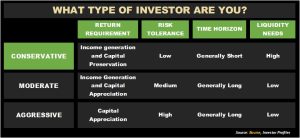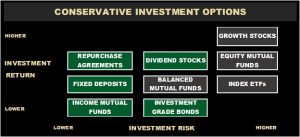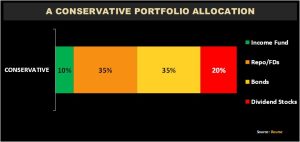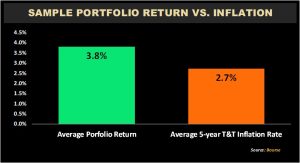HIGHLIGHTS
Conservative Investors
- Characteristics
- Risk Aversion
- Income-oriented
- Capital Preservation/ Loss Aversion
- Liquidity
- Time Horizon
- Conservative Investment Options:
- Income Funds
- Repurchase Agreements (Repos)
- Fixed Deposits
- Bonds
- Dividend Yielding Equities
This week, we at Bourse commence a 2-part series aimed at helping individuals better understand the types of investments they should consider based on their specific investor profile. Investors – looking through the lens of risk tolerance – can make more informed decisions when seeking to build wealth, while staying within their comfort zone when it comes to risk. In this article, we highlight the different types of general investor risk profiles and focus on the Conservative Investor. The Conservative risk profile resonates with many investors, especially those that wish to sustainably build wealth over the long-term with limited periods of volatility. We highlight some common traits of the Conservative Investor; suitable investment options and a suggested portfolio mix that should fit the risk tolerance associated with this investor profile.
What’s Your Investor Profile?

While everyone’s circumstances are unique, investor profiles are a useful tool to broadly describe different types of investors based on their risk tolerance, return requirement, investment time horizon and liquidity needs. Typically, investors can be categorized into three (3) basic profiles: Conservative, Moderate and Aggressive.
The Conservative Investor prioritizes income generation and capital preservation, with limited focus on capital appreciation. The Conservative Investor usually focuses on loss minimization, as opposed to return maximization.
The Moderate Investor, as the name suggests, is prepared to take on moderate risk in exchange for generating returns through a combination of income generation and capital appreciation. Some losses and/or fluctuations to the invested funds are tolerable for this investor.
The Aggressive Investor, in order to maximize returns, is prepared to take greater risk. This investor is typically very focused on growing wealth at a faster rate, cognizant that his/her investments may fluctuate significantly in value.
Are You a Conservative Investor?
The Conservative Investor tends to display the following traits:
- Risk Aversion. Conservative investors seek little to no volatility (low risk) in their investments, content to accept lower returns in exchange for greater investment certainty.
- Income-oriented. Generally, these investors prefer financial instruments that provide a steady income stream in the form of coupons, interest and even reliable dividends.
- Capital Preservation/Loss Aversion – Protecting their initial principal/investment is a primary concern for risk-averse investors, with emphasis on avoiding losses.
- Liquidity. This investor values relatively quick access to funds, opting for investments with a high degree of convertibility to cash in a short time with little to no loss in value.
- Time Horizon. Because of this liquidity preference, the Conservative investor tends to have a shorter investment time horizon. Investments are mostly within 1–3 year tenors, with some funds deployed in medium term (5-7 years) instruments.
Should you consider conservative investing?
Conservative investment strategies can be relevant at any stage of life, depending on an individual’s comfort with risk. Risk tolerance can change over time due to evolving personal experiences, prevailing market conditions or financial circumstances. It may appeal to a wide range of investors including: (i) retirees and near-retirees, (ii) younger individuals, (iii) first-time investors and (iv) entrepreneurs.
- Retirees and Near-Retirees
One common strategy among conservative investors is to adjust their investment allocation based on their age. As individuals get closer to retirement, they may shift their portfolio to contain a higher percentage of low-risk assets such as fixed-income securities. With less time to recover from potential market losses, their focus shifts to preserving capital and generating income. Persons at or near retirement are also typically at peak asset accumulation; investment returns from lower risk/conservative solutions are usually able to fund lifestyle expenses at this stage of life.
- Younger Investors
While younger investors typically have time on their side, those just starting out may adopt a conservative approach to build a strong financial foundation. Prioritizing emergency savings and capital preservation allows them to manage short-term goals and unexpected expenses. Once comfortable, they can gradually shift to a more balanced or growth-oriented strategy.
- First-Time Investors
Conservative investing is a practical starting point for first-time investors. With limited market experience, a cautious strategy helps reduce exposure to volatility and builds confidence over time. Investing in low-risk options can offer a steady entry into the financial markets while minimizing potential setbacks.
- Entrepreneurs
Entrepreneurs often face significant risk in their business ventures, making conservative personal investments a wise counterbalance. By maintaining a low-risk investment portfolio outside their business, they can protect personal capital and ensure access to funds during uncertain periods.
Conservative Investment Options

With the characteristics and preferences of the Conservative Investor in mind, what could be some appropriate investment solutions to satisfy their needs? Conservative solutions are broadly centered around low-risk, fixed-rate, and shorter-term investments such as (i) Income Funds, (ii) Repurchase Agreements, (iii) Fixed Deposits, (iv)Investment Grade Bonds and – to a lesser extent – (v) Dividend-yielding stocks.
Income Funds (specifically Fixed NAV funds) are mutual funds that offer investors a fairly reliable rate of return, with low-to-no risk of capital. They offer good liquidity, with funds readily accessible in a day or two. One of the several money market funds readily available, such as the Savinvest Investment Income Fund (managed by Bourse), is a viable option for investors looking to acquire this investment product.
Repurchase Agreements (Repos) and Fixed Deposits (FDs)
Repos and FDs are essentially short-term, fixed-return investment solutions. Fixed Deposits are offered by banks (including commercial and merchant banks), while Repos are generally offered by Broker-Dealers and other entities. In the case of an FD, the investment has insurance from the Deposit Insurance Corporation up to a limited amount. With Repurchase Agreements, investments are fully secured by financial instruments such as government bonds. Rates on Repos (and FDs) tend to be more attractive than income funds, given that investors are committing to placing their funds for a longer (and fixed) period of time. Repos and FDs investment tenors can range from as little as 90 days to as long as 5 years.
Bonds
A bond is a fixed income instrument in which a lender (investor) loans money to a borrower (bond issuer). In return, the investor receives periodic coupon (interest payments) at fixed and known dates with principal returned on the final maturity date. Bonds issuers include governments, state enterprises and corporations. Bonds tenors typically range from 3 years to 20 years. In extreme cases, some bonds are perpetual, never having a maturity date. Bonds also vary in risk, usually reflected by its credit rating.
For the Conservative Investor, shorter-term (3 to 7 year), higher credit quality bonds may be more appropriate to achieving investment objectives within a desired level of risk. Depending on an investor’s time horizon, risk tolerance (preference for investment grade vs. high yield bonds), and currency availability (TTD or USD), investment grade bonds currently offer yields ranging from 3.5% to 5.0%.
Dividend-Yielding Stocks

For the conservative investor, dividend-paying equities can offer a balanced approach to income generation and capital preservation. While stocks are not traditionally seen as low-risk, companies with (i) relative price stability and (ii) consistent dividend payouts – often well-established blue-chip companies can provide predictable returns and reduced volatility. These stocks deliver a tangible income stream which is appealing during uncertain market conditions and can play a valuable part of an investor’s overall portfolio.
Locally, several stocks within each sector of the Trinidad and Tobago Composite Index (TTCI) offer sector average dividend yields ranging from 2.4% to 5.0%, making them attractive to income-focused investors, while still offering the potential for capital appreciation despite some price fluctuations.
How do Conservative Portfolios Perform?

With a better idea of the portfolio building blocks for the Conservative Investor, just how much could such a portfolio deliver? A sample Conservative Investor portfolio allocation might comprise 10% in Income Funds, 35% in Repos/FDs, 35% in Government bonds and 20% dividend stocks. Based on prevailing returns across these asset classes, the expected weighted return on such a portfolio would typically range between 3.5% – 4.0% annually.
Conservative investing offers lower risk exposure, protection against market volatility, and more predictable returns, making it appealing for investors focused on preserving capital and meeting long-term financial goals. However, this approach also comes with trade-offs, including limited upside potential and lower overall returns compared to more aggressive strategies.

One key consideration is targeting positive inflation-adjusted returns: while conservative portfolios typically yield less, a well-structured portfolio delivering 3.8% annually still outpaces T&T’s 5-year average inflation rate of 2.7%, helping to preserve purchasing power over time.
In addition to selecting investments that align with your risk profile, it’s equally important to ensure your portfolio is well-diversified. Diversification helps spread risk by allocating funds across different asset types (income funds, bonds, and dividend stocks), sectors, and institutions, reducing the impact of any single underperforming investment.
Where possible, incorporating foreign currency investments can also strengthen your portfolio by providing exposure to broader markets. This added layer of diversification enhances long-term stability and can protect your real returns in the face of any local economic-related shocks.
Next week, we take a look at the ‘Moderate’ and ‘Aggressive’ types of Investors and explore suitable investment options in an evolving investment landscape.
DISCLAIMER: “This document has been prepared by Bourse Securities Limited, (“Bourse”), for information purposes only. The production of this publication is not to in any way establish an offer or solicit for the subscription, purchase, or sale of any of the securities stated herein to US persons or to contradict any laws of jurisdictions which would interpret our research to be an offer. Any trade in securities recommended herein is done subject to the fact that Bourse, its subsidiaries and/or affiliates have or may have specific or potential conflicts of interest in respect of the security or the issuer of the security, including those arising from (i) trading or dealing in certain securities and acting as an investment advisor; (ii) holding of securities of the issuer as beneficial owner; (iii) having benefitted, benefitting or to benefit from compensation arrangements; (iv) acting as underwriter in any distribution of securities of the issuer in the three years immediately preceding this document; or (v) having direct or indirect financial or other interest in the security or the issuer of the security. Investors are advised accordingly. Neither Bourse nor any of its subsidiaries, affiliates directors, officers, employees, representatives, or agents, accepts any liability whatsoever for any direct, indirect or consequential losses arising from the use of this document or its contents or reliance on the information contained herein. Bourse does not guarantee the accuracy or completeness of the information in this document, which may have been obtained from or is based upon trade and statistical services or other third-party sources. The information in this document is not intended to predict actual results and no assurances are given with respect thereto.”
